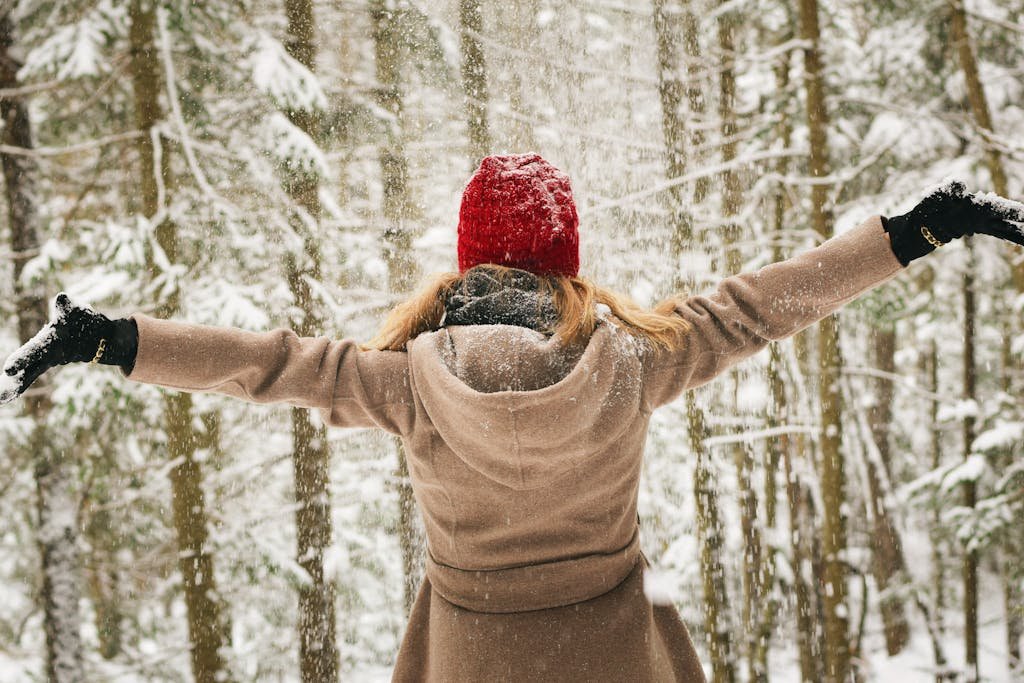Essential Winter Hiking Checklist: 25 Must-Have Items
Prepare for your winter adventures with our comprehensive checklist of 25 essential hiking gear and accessories. Whether you’re a beginner or an experienced hiker, this guide ensures you stay safe, warm, and well-equipped to enjoy the beauty of snowy trails.
Introduction
Winter hiking offers a unique and serene experience, transforming familiar trails into snow-covered wonderlands. However, the season’s beauty comes with its own set of challenges, including harsh weather conditions, slippery terrains, and shorter daylight hours. Proper preparation and the right gear are crucial to ensure safety, comfort, and an enjoyable adventure amidst the cold.
Whether you’re a seasoned hiker looking to tackle more demanding winter trails or a beginner venturing out for the first time, having a comprehensive checklist can make all the difference. Our 25 Essential Items for Winter Hiking guide is designed to equip you with the necessary tools and knowledge to navigate snowy landscapes confidently. From staying warm and dry to ensuring you’re prepared for emergencies, this checklist covers everything you need for a successful winter hike.
25 Essential Items for Winter Hiking
| Item | Purpose | How It Is Helpful |
|---|---|---|
| 1. Winter Hiking Boots | Provide warmth and traction | Insulated and waterproof boots keep feet dry and warm, preventing frostbite and slips on icy paths. |
| 2. Insulated Socks | Enhance foot warmth | Merino or wool socks offer superior insulation and moisture-wicking properties, reducing blisters. |
| 3. Base Layers | Moisture management and insulation | Wicking materials keep sweat away from the body, maintaining warmth and dryness during exertion. |
| 4. Insulating Layers | Additional warmth | Fleece or down jackets provide extra insulation to retain body heat in cold conditions. |
| 5. Waterproof Outer Layer | Protection against snow and wind | Shell jackets and pants block moisture and wind, keeping you dry and reducing heat loss. |
| 6. Backpack | Carrying gear and supplies | A sturdy, weather-resistant backpack distributes weight evenly and holds all essential items securely. |
| 7. Navigation Tools | Route finding and orientation | Maps, compass, and GPS devices help you stay on course and prevent getting lost in snowy terrains. |
| 8. Headlamp | Providing light in low visibility | Essential for early starts, late finishes, or unexpected delays, ensuring you can navigate safely. |
| 9. First Aid Kit | Addressing injuries and emergencies | Contains bandages, antiseptics, and other medical supplies to treat minor injuries and prevent complications. |
| 10. Extra Food and Snacks | Sustaining energy levels | Maps, compasses, and GPS devices help you stay on course and prevent getting lost in snowy terrains. |
| 11. Water and Insulation | Hydration maintenance | Insulated bottles or hydration systems prevent water from freezing, ensuring you stay hydrated. |
| 12. Trekking Poles | Stability and support | Help navigate uneven or icy terrain, reduce strain on joints, and improve overall balance. |
| 13. Emergency Shelter | Protection in case of unexpected overnight stay | Lightweight tents, bivy sacks, or emergency blankets provide crucial shelter from harsh winter elements. |
| 14. Fire Starter | Creating warmth and signaling | Tools like waterproof matches or lighters allow you to start a fire for warmth or to signal for help. |
| 15. Multi-tool or Knife | Versatile utility tool | Useful for gear repairs, food preparation, or first aid tasks, enhancing overall preparedness. |
| 16. Gloves | Hand protection against cold and moisture | Insulated and waterproof gloves keep hands warm and dry, maintaining dexterity and preventing frostbite. |
| 17. Hat or Beanie | Head insulation | Retains body heat as a significant amount of warmth is lost through the head, preventing hypothermia. |
| 18. Sunglasses or Goggles | Eye protection from snow glare and wind | Protect eyes from UV rays reflected off snow and from blowing snow or ice, reducing the risk of eye injuries. |
| 19. Avalanche Safety Gear | Safety in avalanche-prone areas | Items like beacons, probes, and shovels are critical for locating and rescuing individuals in avalanches. |
| 20. Sunscreen and Lip Balm | Protecting skin from UV radiation | Prevents sunburn and chapped lips, which are common even in cold weather due to reflective snow surfaces. |
| 21. Gaiters | Prevent snow and debris from entering boots | Keeps snow, water, and debris out of your boots and lower legs, enhancing comfort and preventing frostbite. |
| 22. Hand Warmers | Provide extra warmth for hands | Disposable or reusable warmers offer additional heat during breaks or in extreme cold, preventing numbness. |
| 23. Personal Locator Beacon (PLB) | Emergency signaling | Sends distress signals with your location to rescue authorities in case of emergencies, crucial for remote areas. |
| 24. Extra Batteries | Powering electronic devices | Ensures that GPS, headlamps, and other battery-powered devices remain functional throughout the hike. |
| 25. Crampons or Microspikes | Provide traction on icy surfaces | Offers additional grip on ice and hard-packed snow, reducing the risk of slipping on treacherous trails. |

Tips for Winter Hiking
- Layer Your Clothing: Utilize the layering system—base layers for moisture management, insulating layers for warmth, and waterproof outer layers for protection against the elements.
- Plan Your Route Carefully: Research your trail thoroughly, considering factors like weather forecasts, trail conditions, and daylight hours.
- Start Early: Maximize daylight by starting your hike early in the morning to avoid getting caught in the dark.
- Stay Hydrated: Even in cold weather, hydration is essential. Drink regularly to maintain energy and body function.
- Pace Yourself: Winter conditions can be more demanding. Take your time to prevent exhaustion and reduce the risk of injury.
- Check Weather Conditions: Continuously monitor weather updates before and during your hike to stay informed about any changes that might affect your safety.
- Leave a Trip Plan: Inform someone about your hiking plan, including your route and expected return time, so help can be dispatched if needed.
Safety Tips
- Understand Avalanche Risks: If hiking in avalanche-prone areas, ensure you have the proper safety gear and know how to use it. Take an avalanche safety course if possible.
- Stay on Marked Trails: Avoid venturing off established trails to reduce the risk of getting lost or encountering unexpected hazards.
- Be Prepared for Emergencies: Carry a fully stocked first aid kit, know basic first aid procedures, and have a plan for emergencies.
- Watch for Signs of Hypothermia and Frostbite: Recognize the symptoms such as shivering, confusion, numbness, and take immediate action if they occur.
- Travel with a Companion: Hiking with a partner increases safety, as you can assist each other in case of injury or unexpected situations.
- Keep Your Gear Accessible: Ensure that essential items like navigation tools, fire starters, and first aid kits are easily reachable in your backpack.
- Avoid Overexertion: Pace yourself to prevent excessive sweating, which can lead to moisture accumulation and increased heat loss.
References and Resources
- Books:
- Winter Hiking: A Complete Guide by David McCandless
- Mountaineering: The Freedom of the Hills by The Mountaineers
- Websites:
- Gear Retailers:
- Safety Courses:
Beginner to Advanced Winter Hikers
Beginner Hikers
- Start with Short Trails: Choose well-marked and relatively flat trails to build confidence and experience in winter conditions.
- Focus on Essential Gear: Prioritize basic items like proper footwear, layered clothing, navigation tools, and a first aid kit.
- Learn Basic Skills: Familiarize yourself with using a map and compass, basic first aid, and understanding weather patterns.
- Hike with Experienced Partners: Joining hikes with more experienced hikers can provide valuable learning opportunities and added safety.
Intermediate Hikers
- Explore Varied Terrains: Gradually take on trails with moderate difficulty, including some elevation changes and varied snow conditions.
- Enhance Your Gear: Incorporate items like trekking poles, hand warmers, and emergency shelters to improve comfort and preparedness.
- Advance Navigation Skills: Utilize GPS devices and learn to read more complex maps, enhancing your ability to navigate in diverse conditions.
- Participate in Safety Courses: Enroll in avalanche safety and winter survival courses to deepen your knowledge and skills.
Advanced Hikers
- Tackle Challenging Trails: Venture into more demanding terrains such as alpine regions, backcountry areas, and avalanche-prone zones.
- Specialized Equipment: Use advanced gear like crampons, ice axes, and avalanche beacons, ensuring proficiency in their use.
- Longer Expeditions: Plan for multi-day hikes, incorporating strategies for overnighting, extended navigation, and self-sufficiency.
- Leadership and Rescue Skills: Develop skills in leading groups, performing rescues, and managing complex emergencies effectively.
Final Thoughts
Winter hiking is a rewarding endeavor that allows you to experience nature’s tranquility and beauty in a unique light. Proper preparation, the right gear, and a solid understanding of safety practices are essential to making the most of your winter adventures. Whether you’re just starting or looking to enhance your existing skills, our comprehensive checklist and resources are here to support you every step of the way. Stay warm, stay safe, and enjoy the crisp winter trails!

